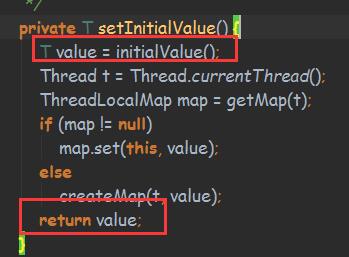一. 对ThreadLocal的理解
ThreadLocal,很多地方叫做线程本地变量,也有地方叫做线程本地存储,其实意思差不多。可能很多朋友都知道ThreadLocal为变量在每个线程中都创建了一个副本,那么每个线程可以访问自己内部的副本变量。
这句话从字面上看起来看容易理解,但真正理解并不是那么容易。
|
1
2
3
4
5
6
7
8
9
10
11
12
13
14
15
16
17
18
|
/**
* 学习ThreadLocal
* Created by mrf on 2016/3/6.
*/
public
class
ConnectionManager {
private
static
Connection connection =
null
;
public
static
Connection openConnection()
throws
SQLException {
if
(connection ==
null
){
connection = DriverManager.getConnection(
"url"
,
"username"
,
"password"
);
}
return
connection;
}
public
static
void
closeConnection()
throws
SQLException {
if
(connection!=
null
)
connection.close();
}
}
|
假设有这样一个数据库连接管理类,这段代码在单线程中使用没有任何问题的,但是如果在多线程就会存在线程安全问题:
- 这里面的2个方法没有同步,很可能在openConnection方法中多次创建connect
- 由于connect是共享变量,那么必然在调用connect的地方需要使用到同步来保证线程安全,因为很可能一个线程在使用connect进行数据库操作,而另外一个线程closeConnection关闭链接
所以出于线程安全的考虑,必须将这段代码的两个方法进行同步处理,并且在调用connect的地方需要进行同步处理。这样会大大影响程序的执行效率,因为一个线程在使用connect进行数据库操作的时候,其他线程只有等待。
那么,大家来自习分析一下这个问题,这地方到底需不需要讲connect变量进行共享?事实上,是不需要的。假如每个线程中都有一个connect变量,各个线程之间对connect变量的访问实际上是没有依赖关系的,即一个线程不需要关心其他线程是否对这个connect进行了修改的。那么直接在使用数据库连接的方法中具体使用时才创建数据库,然后在方法调用完毕再释放这个链接,比如:
|
1
2
3
4
5
6
7
8
9
10
11
12
13
14
15
16
17
18
19
20
21
22
23
|
class
ConnectionManager2{
private
Connection connection =
null
;
public
Connection openConnection()
throws
SQLException {
if
(connection==
null
){
connection = DriverManager.getConnection(
"url"
,
"username"
,
"password"
);
}
return
connection;
}
public
void
closeConnection()
throws
SQLException {
if
(connection!=
null
)
connection.close();
}
}
class
Dao{
public
void
insert()
throws
SQLException {
ConnectionManager2 connectionManager2 =
new
ConnectionManager2();
Connection connection = connectionManager2.openConnection();
//使用connection进行操作
connectionManager2.closeConnection();
}
}
|
这样处理确实也没有任何问题,由于每次都是在方法内部创建的连接,那么线程之间自然不存在线程安全问题。但是这样会有一个致命的影响:导致服务器压力非常大,并且严重影响程序执行性能。由于在方法中需要频繁地开启和关闭数据库连接,这样不仅严重影响程序执行效率,还可能导致服务器压力巨大。
那么这种情况下使用ThreadLocal是再合适不过了,因为ThreadLocal在每个线程中对该变量会创建一个副本,即每个线程内部都会有一个该变量,且在线程内部任何地方都可以使用,线程之间互不影响,这样一来就不存在线程安全问题,也不会严重影响程序执行性能。
但是要注意,虽然ThreadLocal能够解决上面说的问题,但是由于在每个线程中都创建了副本,所以要考虑它对资源的消耗,比如内存的占用会比不是用ThreadLocal要大。
二. 深入解析ThreadLocal类
在上面谈到了对ThreadLocal的一些理解,那我们下面来看一下具体ThreadLocal是如何实现的。
先了解下ThreadLocal类提供的几个方法:
|
1
2
3
4
|
public
T get() { }
public
void
set(T value) { }
public
void
remove() { }
protected
T initialValue() { }
|
get()方法是用来获取ThreadLocal在当前线程中保存的变量副本,set()用来设置当前线程中变量的副本,remove()用来移除当前线程中变量的副本,initialValue()是一个protected方法,一般用来在使用时进行重写的,它是一个延迟加载方法。
首先我们来看一下ThreadLocal类时如何为每个线程创建一个变量的副本的。
先看get方法的实现:
第一句是取得当前线程,然后通过getMap(t)方法获取一个map,map的类型为ThreadLocalMap.然后下面获取到key-value,注意这里获取键值对传进去的是this,而不是当前线程t。
如果获取成功,则返回value值。如果map为空,则调用setInitialValue方法返回value。我们上的每一句来自习分析:
首先看一下getMap方法中做了什么:
可能大家没有想到的是,在getMap中,是调用当前线程t,返回当前线程t中一个成员变量threadLocals.那么继续Thread类中看看成员变量ThreadLocals是什么:
|
1
2
3
|
/* ThreadLocal values pertaining to this thread. This map is maintained
* by the ThreadLocal class. */
ThreadLocal.ThreadLocalMap threadLocals =
null
;
|
实际上就是一个ThreadLocalMap,这个类型是ThreadLocal类的一个内部类,我们继续看ThreadLocalMap的实现:
|
1
2
3
4
5
6
7
8
9
10
11
12
13
14
15
16
17
18
19
20
21
22
23
24
25
26
27
28
29
|
/**
* ThreadLocalMap is a customized hash map suitable only for
* maintaining thread local values. No operations are exported
* outside of the ThreadLocal class. The class is package private to
* allow declaration of fields in class Thread. To help deal with
* very large and long-lived usages, the hash table entries use
* WeakReferences for keys. However, since reference queues are not
* used, stale entries are guaranteed to be removed only when
* the table starts running out of space.
*/
static
class
ThreadLocalMap {
/**
* The entries in this hash map extend WeakReference, using
* its main ref field as the key (which is always a
* ThreadLocal object). Note that null keys (i.e. entry.get()
* == null) mean that the key is no longer referenced, so the
* entry can be expunged from table. Such entries are referred to
* as "stale entries" in the code that follows.
*/
static
class
Entry
extends
WeakReference<ThreadLocal> {
/** The value associated with this ThreadLocal. */
Object value;
Entry(ThreadLocal k, Object v) {
super
(k);
value = v;
}
}
|
可以看到ThreadLocalMap的Entry继承了WeakReference作为键值。然后继续看setInitialValue方法的具体实现:
|
1
2
3
4
5
6
7
8
9
10
11
12
13
14
15
16
|
/**
* Variant of set() to establish initialValue. Used instead
* of set() in case user has overridden the set() method.
*
* @return the initial value
*/
private
T setInitialValue() {
T value = initialValue();
Thread t = Thread.currentThread();
ThreadLocalMap map = getMap(t);
if
(map !=
null
)
map.set(
this
, value);
else
createMap(t, value);
return
value;
}
|
很容易了解,就是如果map不为空,就设置键值对,为空则创建map,看下createMap的实现:
|
1
2
3
4
5
6
7
8
9
10
11
|
/**
* Create the map associated with a ThreadLocal. Overridden in
* InheritableThreadLocal.
*
* @param t the current thread
* @param firstValue value for the initial entry of the map
* @param map the map to store.
*/
void
createMap(Thread t, T firstValue) {
t.threadLocals =
new
ThreadLocalMap(
this
, firstValue);
}
|
至此,可能大部分朋友已经明白了ThreadLocal是如何为每个线程创建变量副本的:
首先,在每个线程Thread内部又一个ThreadLocal.ThreadLocalMap类型的成员变量threadLocals,这个threaLocals就是用来存储实际的变量副本的,键值为当前ThreadLocal变量,value为变量副本(即T类型的变量)。
初始时,在Thread里面,ThreadLocals为空,当通过ThreadLocal变量调用get()方法或者set()方法,就会对Thread类中的threadLocals进行初始化,并且以当前ThreadLocal变量为键值,以ThreadLocal要保存的副本变量为value,存到threadLocals.
然后在当前线程里,如果要使用副本变量,就可以通过get方法在threadLocals里面查找。
下面通过一个例子来证明通过ThreadLocal能达到在每个线程中创建变量副本的效果:
|
1
2
3
4
5
6
7
8
9
10
11
12
13
14
15
16
17
18
19
20
21
22
23
24
25
26
27
28
29
30
31
32
33
34
35
36
37
38
39
40
41
42
|
/**
* 测试ThreadLocal变量在不同线程中变量的值是不同的。
* 因为每个线程都有个副本,然后可以针对副本进行修改而不影响其他线程中变量的副本值
*/
class
TestThreadLocal2{
ThreadLocal<Long> longLocal =
new
ThreadLocal<>();
ThreadLocal<String> stringLocal =
new
ThreadLocal<>();
public
void
set(){
longLocal.set(Thread.currentThread().getId());
stringLocal.set(Thread.currentThread().getName());
}
public
long
getLong(){
return
longLocal.get();
}
public
String getString(){
return
stringLocal.get();
}
public
static
void
main(String[] args)
throws
InterruptedException {
final
TestThreadLocal2 test =
new
TestThreadLocal2();
test.set();
System.out.println(
"===========main线程=============="
);
System.out.println(test.getLong());
System.out.println(test.getString());
Thread t1 =
new
Thread(){
public
void
run(){
test.set();
System.out.println(
"===========t线程=============="
);
System.out.println(test.getLong());
System.out.println(test.getString());
}
};
t1.start();
t1.join();
System.out.println(
"===========main线程=============="
);
System.out.println(test.getLong());
System.out.println(test.getString());
}
}
|
这段代码的输出结果为:
从这段代码的输出结果可以看出,在main线程中和thread0线程中,longLocal保存的副本值和stringLocal保存的副本值都不一样。最后一次在main线程再次打印副本值是为了证明main线程中和thread0线程中的副本值确实是不同的。
总结一下:
- 实际的通过ThreadLocal创建的副本是存储在每个线程自己的threadLocals中的;
- 为何threadLocals的类型为ThreadLocalMap的键值为ThreadLocal对象?因为每个线程中个可以有多个ThreadLocal变量,就像上面的long和string;
- 在进行get之前必须先set,否则空指针异常;如果不想set则必须重写initialValue()方法。因为在上面的代码分析过程中,我们发现如果没有先set的话,即在map中查找不到对应的存储,则会通过调用setInitialValue方法返回i,而在setInitialValue方法中个,有一个语句是T value = initailValue(),而默认情况下,initialValue方法返回的是null。




因此,如果不set则要设置initialValue方法:
三.ThreadLocal的应用场景
最常见的ThreadLocal使用场景为:数据库连接,Session管理等。
|
1
2
3
4
5
6
7
8
9
10
11
12
13
14
15
16
17
18
19
|
/**
* Created by mrf on 2016/3/4.
*/
public
class
TestThreadLocal {
private
static
ThreadLocal<Connection> connectionHolder =
new
ThreadLocal<Connection>(){
public
Connection initialValue(){
try
{
return
DriverManager.getConnection(
"url"
,
"username"
,
"password"
);
}
catch
(SQLException e) {
e.printStackTrace();
}
return
null
;
}
};
public
static
Connection getConnection(){
return
connectionHolder.get();
}
}
|
下面这段代码摘自:
http://www.iteye.com/topic/103804
|
1
2
3
4
5
6
7
8
9
10
11
12
13
14
|
private
static
final
ThreadLocal threadSession =
new
ThreadLocal();
public
static
Session getSession()
throws
InfrastructureException {
Session s = (Session) threadSession.get();
try
{
if
(s ==
null
) {
s = getSessionFactory().openSession();
threadSession.set(s);
}
}
catch
(HibernateException ex) {
throw
new
InfrastructureException(ex);
}
return
s;
}
|




 本文深入解析了ThreadLocal的工作原理及其应用场景,介绍了如何利用ThreadLocal为每个线程创建独立的变量副本,避免线程安全问题,同时提供了数据库连接管理和Session管理等常见应用场景的示例。
本文深入解析了ThreadLocal的工作原理及其应用场景,介绍了如何利用ThreadLocal为每个线程创建独立的变量副本,避免线程安全问题,同时提供了数据库连接管理和Session管理等常见应用场景的示例。
















 4791
4791

 被折叠的 条评论
为什么被折叠?
被折叠的 条评论
为什么被折叠?








